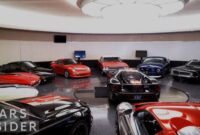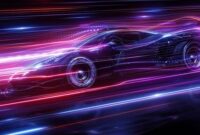The Evolution of Supercars: From Raw Power to Electric Precision
Introduction (250 words)
Supercars have long been the pinnacle of automotive ambition—machines built to push the boundaries of speed, style, and performance. From their roaring V12 engines to today’s whisper-quiet electric motors delivering instant torque, supercars have undergone a dramatic transformation over the past century. The evolution reflects broader technological, environmental, and societal shifts that have redefined what it means to build and drive an “ultimate” car.
This article explores the fascinating journey of supercars—tracing their path from gas-guzzling giants to electrically sophisticated machines, all while examining the key innovations, iconic models, and cultural shifts that have driven the evolution forward.
1. The Birth of the Supercar Era (1920s–1960s) (500 words)
While high-performance cars existed in the early 20th century, the idea of the “supercar” didn’t fully emerge until post-WWII, when technology and wealth began to converge.
Key Highlights:
• Mercedes-Benz 300SL (1954): Often credited as the first true supercar, with its gullwing doors and fuel injection.
• Jaguar E-Type (1961): Enzo Ferrari once called it the most beautiful car ever made.
• Lamborghini Miura (1966): Widely regarded as the first modern supercar with its mid-engine layout and exotic styling.
During this era, performance was raw and unfiltered. There were no driving aids—just powerful engines, lightweight frames, and driver skill.
2. The Rise of Icons (1970s–1980s) (500 words)
This era gave birth to the brands and design philosophies that continue to define supercars.
Legendary Models:
• Ferrari 512 BB
• Porsche 911 Turbo
• Lamborghini Countach
Technological Advancements:
• Rear- and mid-engine layouts became the standard.
• Introduction of turbocharging and fuel injection for more power.
• Greater use of composite materials.
Cultural Impact:
These supercars were status symbols. Their wedge-shaped, aggressive designs became posters on the walls of millions of teenagers around the world. Movies, music videos, and racing added to their mythical status.
3. Performance Meets Precision (1990s–2000s) (500 words)
The ’90s and 2000s brought a shift from raw power to a more precise and refined form of performance.
Game-Changers:
• McLaren F1 (1992): Lightweight, gold-lined engine bay, central driving position—still considered a benchmark.
• Ferrari Enzo (2002): Named after the brand’s founder, featuring F1-derived technologies.
• Bugatti Veyron (2005): Shattered records with 1,000+ hp and a 253 mph top speed.
Technological Milestones:
• Introduction of traction control and launch systems.
• Advanced aerodynamics (active wings, ground effect).
• Carbon fiber monocoque construction.
These innovations allowed supercars to become not just faster but safer and more usable.
4. The Hybrid Revolution (2010s) (500 words)
The 2010s saw the integration of hybrid technology—not for fuel saving, but for enhanced performance.
The “Holy Trinity” of Hybrids:
1. McLaren P1
2. Ferrari LaFerrari
3. Porsche 918 Spyder
Each used electric motors to eliminate turbo lag, improve acceleration, and even enable limited electric-only driving. The idea that supercars could be both fast and green began to take hold.
Other Notable Developments:
• Regenerative braking
• Torque vectoring via electric motors
• Use of AI in driver assistance and track performance analytics
5. Enter the Electric Era (2020s–Present) (600 words)
We are now in the early stages of a new age—the electric supercar era. These vehicles are rewriting the rules of performance and design.
Flagship Electric Supercars:
• Rimac Nevera: 1,914 hp, 258 mph top speed, 0–60 mph in 1.85 seconds.
• Lotus Evija: All-electric, lightweight, with active aerodynamics.
• Pininfarina Battista: Combines Italian design flair with near-2,000 hp electric power.
Why Electric Works for Supercars:
• Instant Torque: Electric motors deliver power immediately, improving acceleration.
• Precision Control: Torque can be independently controlled at each wheel.
• Reduced Complexity: Fewer moving parts mean less maintenance and potentially longer lifespan.
Challenges Faced:
• Battery weight: High-performance EVs must balance range and agility.
• Cooling systems: Managing thermal load at high speeds is critical.
• Charging infrastructure: Still catching up to performance needs.
Despite these hurdles, manufacturers are investing heavily in electrification. Traditional brands like Ferrari and Lamborghini are now developing their first fully electric models.
6. Engineering and Design Transformation (400 words)
As supercars evolved, so did their engineering and aesthetics.
Key Engineering Trends:
• Modular platforms: Enable multiple variants across a brand lineup.
• Active aerodynamics: Spoilers, diffusers, and vents adjust dynamically based on speed and conditions.
• Advanced composites: Carbon fiber reinforced plastics are now standard in most supercars.
Design Evolution:
• From angular and aggressive to fluid and futuristic
• LED lighting and digital displays for futuristic appeal
• Emphasis on aerodynamic function over form
The cockpit is no longer just gauges and switches—today’s supercars feature large touchscreens, haptic feedback, and even augmented reality overlays.
7. Environmental and Regulatory Pressures (300 words)
Governments around the world are imposing stricter emissions and noise regulations. This has forced manufacturers to rethink their powertrains and materials.
Examples:
• Europe’s push to ban internal combustion engines by 2035
• California’s zero-emission vehicle mandates
• Noise pollution laws in urban areas
These changes are leading to the adoption of:
• Plug-in hybrid systems
• Downsized engines with electric assist
• Lightweight construction to offset added battery mass
Supercar manufacturers must now prove that performance can coexist with sustainability.
8. Cultural Shift: Experience Over Speed (250 words)
While top speed remains a bragging right, modern buyers increasingly prioritize driving experience.
Trends in Supercar Culture:
• Track days over straight-line races
• Driver-focused features (adjustable suspension, launch control)
• Enhanced in-car entertainment and connectivity
• Luxury interiors blending Alcantara, carbon fiber, and touchscreen controls
Social media has also transformed how supercars are appreciated. Instagram and YouTube influencers now shape consumer perception as much as traditional auto magazines.
9. The Future of Supercars (500 words)
What does the next decade hold for the supercar?
Predicted Trends:
• Full Electrification: Most brands will offer all-electric supercars by 2030.
• AI Integration: From adaptive suspension to autonomous track modes.
• Augmented Reality HUDs: Overlaying navigation and telemetry on the windshield.
• Solid-State Batteries: Promise lighter weight and faster charging.
• Carbon-Neutral Manufacturing: Sustainability from factory to street.
The Rise of New Players:
While legacy brands like Ferrari, Porsche, and McLaren continue to lead, new players like Rimac, Aspark (Owl), and NIO are challenging the status quo.
Final Thought:
In the future, a supercar may not roar—it may hum. But what will remain unchanged is its purpose: to thrill, to innovate, and to inspire.
Conclusion (200 words)
The journey of supercars is a mirror of human ambition. From the feral machines of the ’60s to the near-silent electric beasts of today, these vehicles have evolved in form and function—yet stayed true to their core: pushing the limits of what’s possible.
As the world moves toward a greener future, the supercar isn’t dying—it’s transforming. It’s becoming smarter, more efficient, and more inclusive. While the scream of a V12 may someday be just a memory, the excitement of piloting a state-of-the-art machine built for pure performance will remain timeless.
The supercar is not just surviving the electric revolution—it’s leading it.



